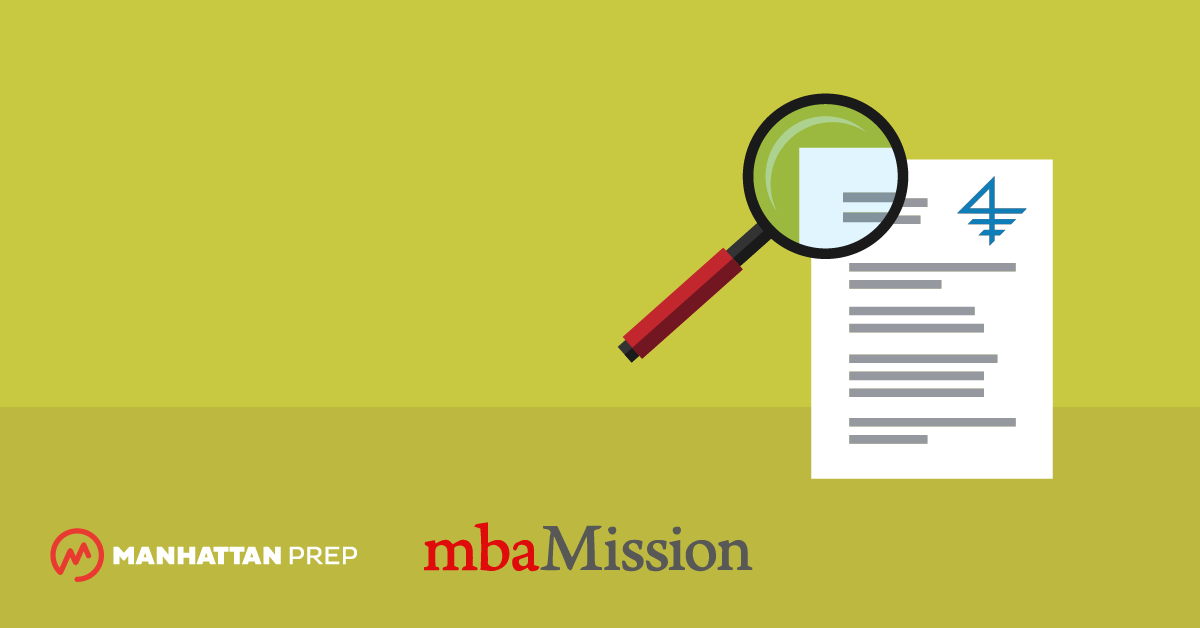Events & Promotions
|
|

GMAT Club Daily Prep
Thank you for using the timer - this advanced tool can estimate your performance and suggest more practice questions. We have subscribed you to Daily Prep Questions via email.
Customized
for You
Track
Your Progress
Practice
Pays
Not interested in getting valuable practice questions and articles delivered to your email? No problem, unsubscribe here.
- Nov 22
11:00 AM IST
-01:00 PM IST
Do RC/MSR passages scare you? e-GMAT is conducting a masterclass to help you learn – Learn effective reading strategies Tackle difficult RC & MSR with confidence Excel in timed test environment - Nov 23
11:00 AM IST
-01:00 PM IST
Attend this free GMAT Algebra Webinar and learn how to master the most challenging Inequalities and Absolute Value problems with ease. - Nov 25
10:00 AM EST
-11:00 AM EST
Prefer video-based learning? The Target Test Prep OnDemand course is a one-of-a-kind video masterclass featuring 400 hours of lecture-style teaching by Scott Woodbury-Stewart, founder of Target Test Prep and one of the most accomplished GMAT instructors.
Kudos
Bookmarks
| FROM Manhattan GMAT Blog: Using Data to Ace the GMAT |
 Over the last two articles, I analyzed what we know about missing GMAT Quant questions and missing GMAT Verbal questions. As it turns out, you can miss a lot of questions on the GMAT. Getting a lot of wrong answers doesn’t guarantee you a bad score—and getting a lot of right answers doesn’t guarantee you a good score. That’s both good news and bad news. On the one hand, the GMAT is a very forgiving test. You can get way more wrong answers on the GMAT than you could on a college final. On the other hand, taking the GMAT is complicated. You aren’t just trying to get a lot of right answers—you’re making tough executive decisions at the same time. 1. Give yourself some free passes on the GMAT. Every single person in our data set, including the highest scorers, missed some questions on the GMAT. That means you’re going to miss some questions on the GMAT. Imagine if the GMAT gave you a list, at the very beginning of each section, of all of those questions you were going to miss. What would you do when you got to one of those questions? Hopefully, you’d guess immediately! If you’re going to miss it anyways, you might as well miss it quickly. Unfortunately, the real GMAT doesn’t give us a list like that. Have you ever spent a very long time on a GMAT question, just to get it wrong in the end? That happened for two reasons: because you thought you were going to get it right, and because you thought you had to get it right. You actually didn’t have to get that problem right! If that was true, then the 700+ scorers in our data set wouldn’t have missed so many questions. On the GMAT, a wrong answer is not your enemy. You can also train yourself to anticipate whether you’ll miss a question. Start with this series of articles on when to guess on the GMAT. Before test day, build a mental list of problems you’re very likely to get wrong—and give yourself permission to miss them. I recommend starting each section with at least three “free passes,” or GMAT questions that you’ll guess on without even trying. You should also cut your losses and guess on any problem that isn’t going your way! Does it mean you’ll miss more questions? Maybe. Does it mean you’ll get a lower score? According to the data, almost certainly not. 2. Don’t spend extra time on the first few GMAT questions. Let’s take a look at three test takers from our data set. They all got nearly the same score on the Quant section, but they did it in three very different ways. Alice (not her real name) started the Quant section strong. Here’s how she performed on each quarter of the Quant section:  Britt had a weaker start:  Finally, Clara was consistent all the way through the section:  There are limits to these data—since Alice, Britt, and Clara took the test at different times and saw different questions, we can’t really directly compare them to each other. However, we can draw a few tentative conclusions from these and the other data. You definitely don’t have to get the first few questions right to get a great score. If you’re strong at a section overall, the GMAT algorithm will eventually figure that out. That’s how Britt and Clara ended up with similar scores. On the other hand, a very strong start doesn’t guarantee you a higher score than someone who started off more slowly. There’s nothing special about the first eight Quant questions or the last eight Quant questions. What the GMAT is looking for is the level you can perform at consistently. You don’t get any bonus points for a strong start if you can’t keep it up! The GMAT data is complicated, but the two pieces of advice we can draw from it are easy to follow and might help you get a stronger score on test day. Here they are:
 Want more guidance from our GMAT gurus? You can attend the first session of any of our online or in-person GMAT courses absolutely free! We’re not kidding. Check out our upcoming courses here. [b]Chelsey Cooley  is a Manhattan Prep instructor based in Seattle, Washington. [/b]Chelsey always followed her heart when it came to her education. Luckily, her heart led her straight to the perfect background for GMAT and GRE teaching: she has undergraduate degrees in mathematics and history, a master’s degree in linguistics, a 790 on the GMAT, and a perfect 170/170 on the GRE. Check out Chelsey’s upcoming GMAT prep offerings here. The post Using Data to Ace the GMAT appeared first on GMAT. |
This Blog post was imported into the forum automatically. We hope you found it helpful. Please use the Kudos button if you did, or please PM/DM me if you found it disruptive and I will take care of it.
-BB
Kudos
Bookmarks
| FROM Manhattan GMAT Blog: Executive Assessment: Fast Math for Faster Solutions (Part 1) |
 The Executive Assessment (EA) shares a lot of roots with the GMAT, GMAC’s flagship graduate business school exam. In certain ways, the Executive Assessment feels almost like the GMAT on steroids—it’s even more stereotypically GMAT-like than the GMAT itself, if that’s possible. One of those ways has to do with the way in which you can solve math problems. Most of the same math content areas are tested on the Executive Assessment, but a higher proportion of released Executive Assessment problems share a certain characteristic: You can use general “Fast Math” principles to make your job much easier—and you can do even more with the overall Fast Math idea on the Executive Assessment. Here’s the overall idea: Don’t do math that you don’t have to. Don’t do math until you have to. Before you actually do something you think you need to do, lay it out and ask yourself what the best path is through the math—giving heavy consideration to estimation and other shortcuts. Let’s try some problems out and see how this really works! All problems in this series are from the free problem sets that appear on the official Executive Assessment website. Give yourself four minutes (total) to try these two problems; we’ll discuss the solution to the first one today and the solution to the second one in our next installment. They currently appear (as of September 2017) as questions 2 and 3 in the free online Quant Problem Solving problem set. “The table below represents the combined net income of all United States companies in each of five sectors for the second quarter of 1996. Which sector had the greatest net income during the first quarter of 1996?  “(A) Basic Materials “(B) Energy “(C) Industrial “(D) Utilities “(E) Conglomerates” “According to the table below, the number of fellows was approximately what percent of the total membership of Organization X?  “(A) 9% “(B) 12% “(C) 18% “(D) 25% “(E) 35%” Got your answers? Even if you’re not sure, guess—that’s what you want to do on the real Executive Assessment, too, so practice that now (even if your practice consists of saying, “I have no idea, so I’m randomly picking B!”). Ready? Let’s do this! In both cases, you’ve got a table of information (though that’s not actually why I grouped these two together), so the first order of business is to understand what the question wants and what the table tells you. Here’s the table for the first problem:  There are 5 sectors. Each one shows a certain net income for the second quarter and then a percent change from the first quarter. What’s the significance of a negative vs. positive percent change? Think in terms of real business. If your division had a net income of 4.83 billion this quarter, but that represents a –26% change from last quarter…then last quarter was better and this quarter your boss might not be very happy. Okay, now what do they want to know? Which sector had the greatest net income in the first quarter… hmm. So we’re going to have to backwards-engineer this somehow. Start by jotting down the starting point for each sector and whether that one was higher or lower in the first quarter: BM: 4.83, –26%….Q1↑ E: 7.46, +40%…….Q1 ↓ I: 5, –1%……………..Q1 ↑ U: 8.57, +303%..Q1 ↓ C: 2.07, +10%…….Q1↓ They want to know which one was the highest once we back out the numbers. Sector C is already the lowest by far and it was even lower last quarter, so it’s not that one. Eliminate answer (E). Sector I only went down by 1% in the second quarter, so basically it was still at about 5 in the first quarter. Call that your baseline point and test the other answers against it. Was Sector BM above or below 5 in the first quarter? The 4.83 figure reflects about a 25% decline from the previous quarter.  If 4.83 represents about a 25% decline from Q1, then it represents about 75% of Q1. Use this to estimate the value for Q1: If the 4.83 figure is about 75%, then what would 25% be? You would divide 75% by 3 to find 25%, so do the same with the value 4.83. 4.83 is kind of annoying to divide. Try a number that seems like it’s in the ballpark, like 1.5. (1.5)(3) = 4.5, so the value is around 1.5 (but really a little larger). The 1.5 estimate, then, is on the low side. Keep track of that.  Then, multiply by 4 to find 100%: (1.5)(4) = 6. The value is really a little larger than 6, since 1.5 is a low estimate. Therefore, sector BM, at 6+, was more than sector I, at 5; eliminate answer (C). Your new baseline point is 6+. Test the remaining answers against this number. The other two sectors were both lower in Q1. For sector E, 7.46 reflects a 40% increase from Q1. What if the starting number for this sector were 6? What would a 40% increase be? 6 + 40% of 6 To find 40%, find 10%, then multiply by 4. Then add your starting point of 6 back in: (6)(0.1) = 0.6 (0.6)(4) = 2.4 6 + 2.4 = 8.4 If Q1 were 6, then this sector would have been at 8.4 in the second quarter. It wasn’t; it was only at 7.46. Sector E, therefore, was not as high as sector BM, so eliminate choice (B). Finally, sector U started at 8.57, but that represented a whopping 303% increase over Q1! If you started at 6 and increase that number by 300%, it would be way over 8.57. Sector U also must have started lower than 6, so eliminate choice (D). The Basic Materials sector is the last one standing. The correct answer is (A). You could have done all of the above with very precise calculations—but that’s really annoying when you don’t have access to a calculator or Excel. Note that you didn’t actually have to make very precise calculations because the problem was set up to allow you to estimate even though it didn’t tell you that you could. The beauty of the Executive Assessment is that this is a business test, not a math test. They’re not interested in knowing whether you can do precise math calculations on paper. They’re interested in knowing whether you have a general number sense that allows you to reason your way to a conclusion—we call that the “back of the envelope” approach. All my boss really needs to know is which division did best last quarter, not what the exact numbers were, so I can just do a quick-and-dirty approach that addresses the big picture. Key Takeaways for Executive Assessment Fast Math (1) You often don’t need to calculate exact values. Look for opportunities to estimate and do back-of-the-envelope calculations wherever possible. (2) You’re going to need to practice that! First, you need to get yourself into the mindset that the Executive Assessment isn’t a math test and you actually aren’t just trying to calculate, calculate, calculate. Second, you’re going to need to spend time thinking about how to back-of-the-envelope something in various different situations. (3) Turn that knowledge into Know the Code flash cards:   *Executive Assessment questions courtesy of the Graduate Management Admissions Council. Usage of this question does not imply endorsement by GMAC. Can’t get enough of Stacey’s GMAT mastery? Attend the first session of one of her upcoming GMAT courses absolutely free, no strings attached. Seriously.  Stacey Koprince is a Manhattan Prep instructor based in Montreal, Canada and Los Angeles, California. Stacey has been teaching the GMAT, GRE, and LSAT for more than 15 years and is one of the most well-known instructors in the industry. Stacey loves to teach and is absolutely fascinated by standardized tests. Check out Stacey’s upcoming GMAT courses here. The post Executive Assessment: Fast Math for Faster Solutions (Part 1) appeared first on GMAT. |
This Blog post was imported into the forum automatically. We hope you found it helpful. Please use the Kudos button if you did, or please PM/DM me if you found it disruptive and I will take care of it.
-BB
Kudos
Bookmarks
| FROM Manhattan GMAT Blog: How to Use Parallel Construction in Your MBA Application Essays |
 Longer and more complex sentences often require parallel construction. Simply put, parallel construction ensures that any given longer sentence has a standard rhythm or construction. With parallel construction, each pronoun corresponds with another pronoun, each verb corresponds with another verb, each adjective matches with a corresponding adjective, and so on. Parallel construction can certainly be found in shorter sentences as well, and to great effect. Consider the example of Hamlet’s words “To be or not to be”—some of the most famous in the English language. Shakespeare wrote this short sentence in perfect parallel form; “to be” is matched perfectly with its corresponding negative “not to be” and is separated only by the necessary word “or.” Another short example of parallel construction from history is “I came, I saw, I conquered.” With these words, Julius Caesar spoke in perfect parallel construction—the grammatical form is a pronoun (the word “I”) followed by a verb in the past tense (“came,” “saw,” “conquered”). If we were to change that second famous phrase just a touch, the amazing quality it now has would be lost, and the phrase would become unremarkable. For example, if Caesar had said, “I came, I saw, and I became the conqueror,” he would likely not be quoted today, because the rhythm would have been destroyed. Keep this rule in mind for everything that you write, especially for longer sentences. Here are a few more examples: Bad: We are successful for three key reasons: understanding our client, trying harder than our competition, and teamwork. Good: We are successful for three key reasons: understanding our client, trying harder than our competition, and working as a team. (In this example, gerunds [the words ending in “ing”] parallel each other, unlike in the previous, “bad” example.) Bad: We are in the forestry business. We sell wood to hardware stores and paper to stationery stores. Good: We are in the forestry business. We sell wood and paper. On another note, we have previously discussed the importance of thoroughly exploring and accessing your personal stories when writing your MBA application essays. Of course, having too much of a good thing is always a risk as well—admissions committees can be put off by candidates who go too far and become too personal. Some stories are particularly challenging for admissions committees. For example, we strongly discourage candidates from writing about divorce as a moment of failure. If an individual were to take responsibility in an essay for a failed marriage, he/she would likely end up revealing intensely personal issues, rather than portraying him-/herself as having learned from a constructive professional or personal challenge. Always keep in mind that in many ways, the admissions committee is meeting you for the first time via your application. So, a simple way to judge whether you are being too personal in your materials is to ask yourself, “Would I be uncomfortable if, immediately upon meeting someone, he/she were to share this sort of information with me?” If your answer is “yes,” you should most likely consider changing your topic.   mbaMission is the leader in MBA admissions consulting with a full-time and comprehensively trained staff of consultants, all with profound communications and MBA experience. mbaMission has helped thousands of candidates fulfill their dream of attending prominent MBA programs around the world. Take your first step toward a more successful MBA application experience with a free 30-minute consultation with one of mbaMission’s senior consultants. Click here to sign up today. mbaMission is the leader in MBA admissions consulting with a full-time and comprehensively trained staff of consultants, all with profound communications and MBA experience. mbaMission has helped thousands of candidates fulfill their dream of attending prominent MBA programs around the world. Take your first step toward a more successful MBA application experience with a free 30-minute consultation with one of mbaMission’s senior consultants. Click here to sign up today.The post How to Use Parallel Construction in Your MBA Application Essays appeared first on GMAT. |
This Blog post was imported into the forum automatically. We hope you found it helpful. Please use the Kudos button if you did, or please PM/DM me if you found it disruptive and I will take care of it.
-BB









































